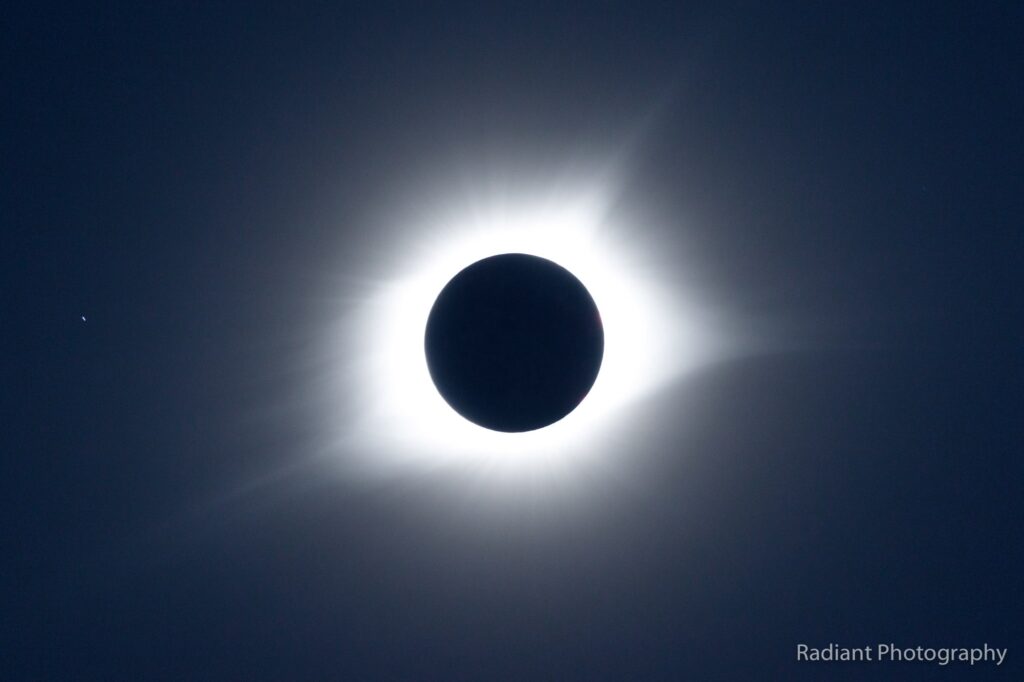
I’ve been seeing a lot of questions online about how to photograph the eclipse or what kind of filters to use. I photographed the last eclipse back in August 2017 (I captured the photo above during totality). Here are some tips from that experience…
During totality, you’re safe photographing without a filter at any focal length. The sun is blocked, and it looks like night up toward the sun (which is just a mildly-bright ring in the sky), and lighter along the horizon. I would estimate that looking at the sun in totality is about as comfortable as looking up at a full moon in a night sky.
It’s tricky when you are in totality though, because you can get caught off-guard when totality ends if you haven’t put the filter back on your camera (or if you are viewing the sun while totality ends). Set a timer for just before totality is supposed to end to give yourself a heads-up.
If you are out of totality at all (even at 99% coverage), you need a filter if your camera is pointed straight at the sun at a medium to telephoto focal length (> 35-50mm). If you have a wider angle lens and frame the sun mid-frame or near an edge, less sunlight is directly impacting your sensor and you don’t need a filter. Without a filter, you still need to use some caution when the sunlight isn’t hitting your lens straight-on, because you can always damage the side of your lens barrel or the edge of your camera mount, if the sunlight gets focused on those areas by being off-center.
So how do you determine if you are zoomed in enough to need a filter? If you are consciously “zooming in” to take a picture of the sun, use a filter. If you are taking a picture of the environment around you, like you would on any other sunny day, and the sun just happens to be in the frame, you probably don’t need a filter.
Assuming you need to choose a filter, solar filters are safer than ND filters (no matter the strength of the ND). ND filters are only guaranteed to block visible light, but the sun projects a much broader range of the EM spectrum. Solar filters will block that ultraviolet and long wave IR light as well. If the other wavelengths aren’t blocked, you could damage your camera sensor (or worse, your eyes) from something you can’t even physically see. Make sure your solar filter is ISO 12312-2 certified.
When photographing an eclipse with a mirrorless camera, you are more likely to damage the camera. When photographing with a DSLR, you are more likely to damage your eyes. With a DSLR, if you are pointed at the sun and the mirror is closed (assuming you aren’t in live view or capturing video), then any strong sunlight will reflect off the mirror, through the prism and out the viewfinder. The camera itself is relatively safe, because the light is only passing through it. With a mirrorless camera, the light will be hitting the sensor or shutter at all times, either burning the sensor or melting the thin blades of the shutter. In other words, the camera can be damaged much more easily, but at no point can the sunlight reach your eyes because you are just looking at a screen.
With all this being said, for my setup this time around I’ll be using a DSLR with a 400mm lens and solar filter to photograph the sun. That way I can remove the filter during totality without much risk of damaging the camera if totality ends before I’m able to put the filter back on. Additionally, I’ll setup my modern mirrorless camera to capture photos and video of the landscape around us at around 24mm with a manual exposure adjusted for a daytime scene. This will give me a way to capture the event in multiple ways with minimal chance of damaging my cameras or eyesight.
Wishing you clear skies…